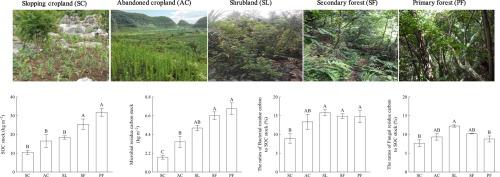Science of the Total Environment ( IF 9.8 ) Pub Date : 2020-12-04 , DOI: 10.1016/j.scitotenv.2020.143945 Zhiming Guo , Xinyu Zhang , Jennifer A.J. Dungait , Sophie M. Green , Xuefa Wen , Timothy A. Quine

|
Carbon sequestration is a key soil function, and an increase in soil organic carbon(SOC) is an indicator of ecosystem recovery because it underpins other ecosystem services by acting as a substrate for the soil microbial community. The soil microbial community constitutes the active pool of SOC, and its necromass (microbial residue carbon, MRC) contributes strongly to the stable SOC pool. Therefore, we propose that the potential for restoration of degraded karst ecosystems lies in the abundance of soil microbial community and the persistence of its necromass, and may be measured by changes in its contribution to the active and stable SOC pools during recovery. We investigated changes in SOC stocks using an established space-for-time chronosequence along a perturbation gradient in the subtropical karst ecosystem: sloping cropland< abandoned cropland < shrubland < secondary forest < primary forest. Microbial biomarkers were extracted from soil profiles from surface to bedrock and used to measure the contributions of the soil microbial community composition (using phospholipid fatty acids, PLFAs) and MRC (using amino sugar) to SOC stocks at each recovery stage. The results showed that the SOC stocks increased with recovery stage, with total MRC accounting for 17-28 % of SOC. Increasing PLFAs and MRC abundances were positively correlated with improved soil structure and SOC, nitrogen and phosphorus nutrient. Bacterial MRC contributes more to SOC stocks than fungal MRC during vegetation recovery. The PLFA analysis indicated that Gram positive bacteria were the largest microbial group and were relatively more abundant in deeper soils, and biomarkers for saprophytic and ectomycorrhizal fungi were more abundant in soils under woody vegetation. In conclusion, this study suggests that the soil microbial community in karst soils have the potential to adapt to changing soil conditions and contribute substantially to building SOC stocks after abandonment of agriculture in degraded karst landscapes.
中文翻译:

亚热带喀斯特生态系统植被恢复过程中土壤微生物坏死对SOC种群的贡献
碳固存是关键的土壤功能,土壤有机碳(SOC)的增加是生态系统恢复的指标,因为它通过充当土壤微生物群落的底物来支撑其他生态系统服务。土壤微生物群落构成了SOC的活性库,其坏死(微生物残留碳,MRC)对稳定SOC池有很大贡献。因此,我们建议恢复退化喀斯特生态系统的潜力在于土壤微生物群落的丰富性及其坏死的持久性,并且可以通过恢复过程中其对活跃和稳定的SOC库的贡献的变化来衡量。我们研究了亚热带喀斯特生态系统中沿扰动梯度建立的时空时空序列的SOC储量变化:坡耕地< 废弃农田<灌木丛<次生林<原始森林。从地表到基岩的土壤剖面中提取微生物标志物,并在每个恢复阶段用于测量土壤微生物群落组成(使用磷脂脂肪酸,PLFA)和MRC(使用氨基糖)对SOC储量的贡献。结果表明,SOC的存量随着恢复期的增加而增加,MRC总量占SOC的17-28%。PLFA和MRC含量的增加与土壤结构的改善以及SOC,氮和磷的养分呈正相关。在植被恢复过程中,细菌MRC对SOC的贡献要大于真菌MRC。PLFA分析表明,革兰氏阳性菌是最大的微生物群,在较深的土壤中相对较多,木本植被下土壤中腐生真菌和外生菌根真菌的生物标志物含量较高。总之,这项研究表明,喀斯特土壤中的微生物群落具有适应变化的土壤条件的潜力,并且在退化的喀斯特景观中放弃农业后,对建立SOC储量有很大贡献。


























 京公网安备 11010802027423号
京公网安备 11010802027423号